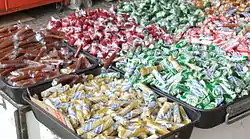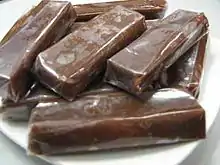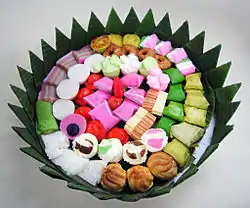Dodol
Dodol is an Indonesian sweet toffee-like sugar palm-based confection commonly found in Southeast Asia and the Indian subcontinent.[2] It is popular in Indonesia, Malaysia, Singapore, Brunei, the Philippines, South India, Sri Lanka, Thailand, and Burma, where it is called mont kalama. It is made from coconut milk, jaggery, and rice flour, and is sticky, thick, and sweet.[3][1]
 Assorted Garut dodols on display in Bandung, the most popular variant of Dodol | |
| Type | Confectionery |
|---|---|
| Place of origin | Indonesia[1] |
| Region or state | Southeast Asia and Indian subcontinent |
| Main ingredients | Coconut milk, jaggery, rice flour |
Cultural significance
In Muslim majority countries, such as Indonesia and Malaysia, dodol is commonly served during festivals, such as Eid ul-Fitr and Eid al-Adha as sweet treats for children.[4][3] The Betawi people take pride in making homemade dodol during the Lebaran (Eid ul-Fitr), where family members will gather together to make dodol. Traditional home made dodol Betawi production center is located in Pasar Minggu area, South Jakarta.[5] The town of Garut in West Java is the main production center of dodol in Indonesia. In Indonesia, durian dodol is popular in Medan and other Sumatran cities. Many flavours of dodol are available, including a durian flavor called lempuk, which is available in Asian food stores.
Dodol is also popular among the Roman Catholics from the Indian west coast, also known as the former Estado da Índia Portuguesa, which includes East Indians from Mumbai, the state of Goa, and the city of Mangalore. Dodol Hj Ideris manufactures dodol and the company has now entered the Middle Eastern market, including Iran.[6]
History
The history of dodol production is closely related to one of its main ingredients, gula aren or palm sugar, a traditional sugar made from the sap of Arenga pinnata plant, and also rice flour. It is a popular sweet treat and one of the oldest indigenous sweets developed in the Maritime Southeast Asia. The exact origin of dodol is unclear, nevertheless, dodol shows its remarkable diversity in the island of Java and Sumatra, although the variants are adaptations of post-colonial crops.[4] In Javanese language it is called jenang, while in Sundanese of West Java "dodol".
Dodol is believed to have been introduced to Southern India and Sri Lanka by Indonesians.[7] It has also been attributed to the Portuguese, who occupied parts of the country during the 16th and 17th centuries.[8] Several dodol recipes have been developed in Sri Lanka, such as kalu dodol.
A related dessert in the Philippines is known as kalamay (literally "sugar"), which is made from sugarcane sugar instead of palm sugar. It also has a liquid consistency unlike dodol, since it uses ground glutinous rice rather than rice flour. However, the basic ingredients and preparation is similar.[9] In Mindanao and the Sulu Archipelago of the southern Philippines, dodol is more similar to the Indonesian and Malaysian variants and is known by the same name. It is usually prepared into thick cylinders wrapped in corn husks or coloured cellophane that is then cut into disks before serving. Although, like the kalamay, Filipino dodol is made with ground glutinous rice paste and muscovado sugarcane sugar, not palm sugar.[10][11]
Preparation

Dodol is made from coconut milk, jaggery, and rice flour, and is sticky, thick, and sweet. The cooking process would reduce the contents up to half as the liquid evaporates. It normally takes up to 9 hours to cook. During the entire cooking process, the dodol must be constantly stirred in a big wok. Pausing in between would cause it to burn, spoiling the taste and aroma. The dodol is completely cooked when it is firm, and does not stick to one's fingers when touching it.[1] Actually now there are dodol arrowroot with various flavors such as strawberries, guava, durian, and others. In addition to various flavors, there is now also one producer of garut dodol that combines chocolate and dodol to be used as souvenirs from the city, commonly called 'chocodot' or chocolate dodol.[12]
Variants

Indonesia
The Indonesians are the most adventurous and creative in concocting dodol. There are interesting varieties such as dodol garut, dodol kacang hijau (mung beans), dodol bengkoang (jicama), dodol nangka (jackfruit), dodol ubi talam (yam), dodol sirsak (soursop), dodol tomat (tomato), dodol tape (tapai), dodol apel malang (apple), dodol salak, dodol rumput laut (seaweed), dodol pisang (banana), dodol nenas (pineapple), dodol mangga (mango), and dodol lidah buaya (Aloe vera). Then there is dodol betawi, which takes a bit more effort to make as it uses white and black glutinous rice.[4]
The variants among others are:
- Dodol garut is produced in Garut, a regency of West Java province, Indonesia.
- Dodol durian contains durian.
- Dodol sirsak contains soursop.
- Dodol nangka contains jackfruit.
- Dodol apel Malang contains apple, and is a speciality of Malang city, East Java.
- Dodol susu is from Pangalengan, Bandung, West Java. It contains milk.
- Dodol China is an Indonesian Chinese version of sweet nian gao with rich coconut sugar.
- Dodol Betawi is made by the Betawi people in Jakarta, and is similar to Chinese dodol.
Pejorative meaning
In Indonesia's popular culture, 'dodol' in colloquial Indonesian can also be used as a slang for the word 'bodoh' to refer a person as being 'stupid' or 'illogical'. It is impolite to refer a person as 'dodol'.[14]
See also
References
- Wibisono Notodirdjo (7 August 2011). "Sweet treats from the past". The Jakarta Post. Jakarta.
- "What Is Dodol?". wiseGEEK.
- Bhuwon Sthapit; Hugo A.H. Lamers; V. Ramanatha Rao; Arwen Bailey, eds. (2016). Tropical Fruit Tree Diversity: Good Practices for in Situ and On-farm Conservation, Issues in Agricultural Biodiversity. Routledge. ISBN 9781317636229.
- Zieman (21 June 2014). "Dodol: Sticky treat for Hari Raya". The Star.
- "Menengok Pabrik Dodol Betawi Haji Tholib, Banyak Dapat Pesanan". Warta Kota (in Indonesian). 25 October 2016.
- Market For Dodol Hj Ideris Expands To Middle East
- Guruge, Ananda (2003). Serendipity of Andrew George. AuthorHouse. pp. 402–403. ISBN 9781410757029.
- Handunnetti, Dilrukshi (28 February 1999). "Hambantota: the kalu dodol capital". The Sunday Times. Retrieved 8 April 2013.
- "Calamay from Bohol". marketmanila.com. 22 June 2010. Retrieved 7 January 2011.
- Damo, Ida. "Dodol: A Maranao Delicacy Perfect for Ramadan". ChoosePhilippines. Retrieved 2 June 2019.
- Tan, Kiki. "Discovering 'dodol'". Mindanaw. Retrieved 2 June 2019.
- "Sejarah Dodol Garut » Budaya Indonesia". budaya-indonesia.org. Retrieved 21 October 2019.
- Molesworth Allen, Betty (1967). Malayan fruits: an introduction to the cultivated species. Singapore: D. Moore Press. p. 99.
- Yusup Priyasudiarja (2010). Kamus Gaul Percakapan Bahasa Inggris Indonesia-Inggris. PT Mizan Publika. ISBN 978-9791284738.
External links
- Dodol Indonesian sticky caramel toffee dessert a video from eastcodeTravel
- Recipe

